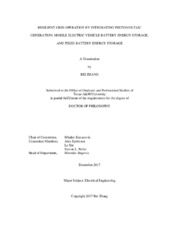| dc.description.abstract | The widespread utilization of photovoltaic (PV) generation, and battery energy storage (BES) in mobile (Electrical Vehicles-EVs) and fixed form is bringing opportunities, as well as challenges to the power grid operation.
To handle the uncertainties brought by EV BES, and PV generation, we propose to improve the system predictability through: 1) an analytical way to estimate the aggregated EVs BES power capacity for charging/discharging, considering factors such as EVs’ mobility, drivers’ stochastic behavior, energy need for future travel, etc.; and 2) an improved PV generation forecast based on Gaussian Conditional Random Fields (GCRF) method, which models both the spatial and temporal correlations in different graphs and works well even with missing or unavailable data.
One of the opportunities is to improve the system flexibility by utilizing the relatively high ramping capability of mobile (EV) and fixed BES given their quite adjustable operation modes (charging and discharging). This dissertation presents a model to integrate EVs and fixed BES into the ramp market with two types of participation: a) direct participation, and b) collaboration with conventional generators. By providing the ramp service in the electricity market, EVs and fixed BES can help the power grid better handle the short term net-load variability and uncertainty. On the other hand, EVs and fixed BES do not have to charge and discharge very frequently, while their fast ramping capability can still get rewarded. Also, the limitation on the energy capacity of EVs and fixed BES can be relieved to some extent.
As another opportunity, the integration of PV generation and fixed BES can also help the system in face of some unknowable uncertainties, such as the extreme event. The energy stored in the BES and generated by the PV panel can serve as the emergency power supply. Also, they are located in a more scattered manner than the conventional generators, which enables their capacity to be more accessible under the extreme conditions. This dissertation proposes an optimal allocation scheme of PV generation and fixed BES aiming at improving the system resilience, considering the unknowable nature of extreme events. | en |


